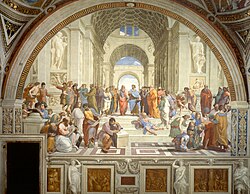Felice Feliciano
- Machine translation, like DeepL or Google Translate, is a useful starting point for translations, but translators must revise errors as necessary and confirm that the translation is accurate, rather than simply copy-pasting machine-translated text into the English Wikipedia.
- Do not translate text that appears unreliable or low-quality. If possible, verify the text with references provided in the foreign-language article.
- You must provide copyright attribution in the edit summary accompanying your translation by providing an interlanguage link to the source of your translation. A model attribution edit summary is
Content in this edit is translated from the existing Italian Wikipedia article at [[:it:Felice Feliciano]]; see its history for attribution. - You may also add the template
{{Translated|it|Felice Feliciano}}to the talk page. - For more guidance, see Wikipedia:Translation.
| Renaissance |
|---|
 The School of Athens (1509–1511) by Raphael |
| Aspects |
|
| Regions |
|
| History and study |
|
Felice Feliciano (Verona 1433 - Rome 1479) was a fifteenth-century calligrapher, composer of alchemical sonnets, collector of drawings and expert on Roman antiquity, especially inscriptions on stone.[1][2]
Biography
He lived just long enough to see printing arrive in Italy. He was the first to recreate geometrically the alphabet of Roman inscriptions, in 1463. The original copy of Alphabetum Romanum, his treatise on the geometrical construction of Roman capital letters using the square and circle, is preserved in the Vatican Library (Codex Vat. lat. 6852). In 1470 while in Bologna as Vicario di Castel San Giorgio, he became acquainted with Sabadino degli Arienti, who mentioned him in his III and IV Porretane. He started printing in 1476 in Poiano, near Verona. In 1478, he travelled to Rome, visiting his friend Francesco Porcari.
Felix Titling font

Monotype's Felix Titling (1934) is based on a 1463 alphabet of Feliciano.[3][4]
Works
- Alphabetum Romanum (1463)
- Poems and epistles : with novellas by other authors (1471–1472)
Further reading
- Jason Dewinetz, Alphabetum Romanum: The Letterforms of Felice Feliciano c. 1460, Verona (2010. Greenboathouse Press, Vernon BC)
References
- ^ Dr Evelyn Karet (28 March 2014). The Antonio II Badile Album of Drawings: The Origins of Collecting Drawings in Early Modern Northern Italy. Ashgate Publishing, Ltd. pp. 135–146. ISBN 978-0-7546-6571-7.
- ^ Evelyn Karet; Stefano (da Verona) (January 2002). The Drawings of Stefano Da Verona and His Circle and the Origins of Collecting in Italy: A Catalogue Raisonné. American Philosophical Society. pp. 28–35. ISBN 978-0-87169-244-3.
- ^ "Felix Titling". MyFonts. Retrieved 20 August 2016.
- ^ "Felix Titling". MyFonts. Retrieved 20 August 2017.











